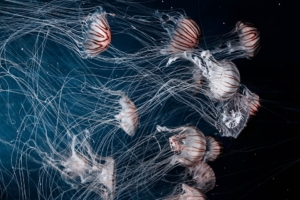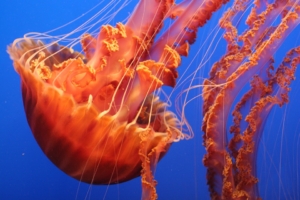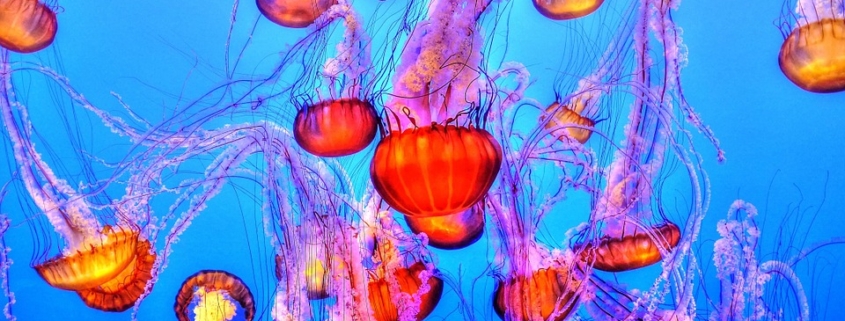Receiving their namesake from their jelly-like bodies, jellyfish are found in all of the world’s five oceans. As a diver, you’ll probably encounter them during your underwater adventures. Even if you’re familiar with the general appearance and behaviors of jellyfish, though, there are probably some things you don’t know about these marine animals.
#1) Jellyfish Don’t Have Bones
While us humans have over 200 bones in our body, jellyfish don’t have any bones. As a result, jellyfish aren’t classified as fish. Fish are marine vertebrates that have a backbone. Since jellyfish don’t have a backbone, nor any bones for that matter, some marine biologists have been encouraging the public to call them “sea jellies” or simply “jellies,” instead. So, what are jellyfish made of if they don’t have bones? Most jellyfish consist of an external epidermis as well as an internal gastrodermis. They still have nerves and muscles, but they don’t have any bones. Their lack of bones is responsible for their jelly-like appearance.
#2) Jellyfish Have Been Around for Over a Half-Billion Years
 To say jellyfish are old would be an understatement. While it’s unknown exactly when jellyfish first appeared, marine biologists say they’ve been around for at least 500 million years. Considering that dinosaurs are just 66 million years, that’s pretty impressive to say the least. During that time, jellyfish have remained one of the world’s most resilient marine animals. They are able to survive in a wide range of aquatic environments while also reproducing at incredibly fast rates.
To say jellyfish are old would be an understatement. While it’s unknown exactly when jellyfish first appeared, marine biologists say they’ve been around for at least 500 million years. Considering that dinosaurs are just 66 million years, that’s pretty impressive to say the least. During that time, jellyfish have remained one of the world’s most resilient marine animals. They are able to survive in a wide range of aquatic environments while also reproducing at incredibly fast rates.
#3) Jellyfish Can Lay Up to 45,000 Eggs Per Day
You might be surprised to learn that jellyfish can lay up to 45,000 eggs per day. As the eggs mix with sperm, which is released by other jellyfish, they become fertilized. The fertilized eggs will then hatch to reveal flatworms known as planulae. Some of these planulae will then develop into full-grown jellyfish, whereas others will enter a polyp stage. When compared to other common marine animals, jellyfish have a complex reproduction cycle. But with jellyfish laying up to 45,000 eggs per day, they are able to quickly reproduce and spread. Their complex reproduction cycle is a key reason why jellyfish populations throughout the world are increasing.
#4) Jellyfish Are Comprised of Roughly 95% Water
According to the National Oceanic and Atmospheric Administration (NOAA), jellyfish are comprised of roughly 95% water — with only the remaining 5% of their bodies consisting of solid organic matter like collagen and other tissues. The high water content of jellyfish allows these marine animals to swim more freely and easily. It essentially improves their buoyancy, thereby reducing the amount of physical effort required by jellyfish to swim. If jellyfish were comprised of less water, they wouldn’t be able to move so gracefully through the water, which would likely inhibit their ability to reproduce. Because jellyfish are comprised of roughly 95% water, though, this isn’t a problem.
#5) One Species of Jellyfish Is Immortal
The Turritopsis dohrni has been dubbed the “immortal jellyfish” because of its ability to revert to a sexually immature stage. Other species of jellyfish have a typical life cycle in which they develop from polyps into sexually mature adults. The immortal jellyfish is unique, however, because it’s able to revert back to a polyp. As the immortal jellyfish grows old, it uses some of its existing tissue to trigger a growth reversion process known as transdifferentiation. This process turns back the hands of time, so to speak, allowing the immortal jellyfish to revert to sexual immaturity. As a result, the immortal jellyfish doesn’t die from old age. It can still die from other causes, such as predators, but it’s natural ability to revert to a polyp allows it to outlive most other species of jellyfish.
#6) Jellyfish Can Weight Hundreds of Pounds
Jellyfish can grow incredibly big, with some species weighing hundreds of pounds when fully grown. The Nomura jellyfish, for example, is the world’s largest jellyfish. There are reports of Nomura jellyfish growing to up to seven in feet in diameter and weighing over 500 pounds. Nomura jellyfish are commonly found in the warm waters separating China and Japan. In a period of just six months, a single Nomura jellyfish can grow from the size of a rice grain to over 6 feet in diameter. Therefore, the Nomura jellyfish isn’t just the world’s largest species of jellyfish; it’s the world’s fastest-growing species of jellyfish.
#7) Jellyfish Have Millions of Stinging Cells
 Jellyfish have millions of stinging cells, which they use to stun prey. The stinging cells are attached to long tentacles. When a jellyfish comes across prey, it will wrap its tentacles around the prey. The stinging cells will then inject toxin into the prey, resulting in paralysis. Of course, the severity of a jellyfish’s sting varies depending on the species. In humans, some species of jellyfish only cause minor pain. Other species of jellyfish, however, can cause severe pain or even anaphylaxis shock. In the Philippines alone, it’s estimated that jellyfish kill approximately 2o to 40 people each year, making them significantly more deadly than sharks.
Jellyfish have millions of stinging cells, which they use to stun prey. The stinging cells are attached to long tentacles. When a jellyfish comes across prey, it will wrap its tentacles around the prey. The stinging cells will then inject toxin into the prey, resulting in paralysis. Of course, the severity of a jellyfish’s sting varies depending on the species. In humans, some species of jellyfish only cause minor pain. Other species of jellyfish, however, can cause severe pain or even anaphylaxis shock. In the Philippines alone, it’s estimated that jellyfish kill approximately 2o to 40 people each year, making them significantly more deadly than sharks.
#8) Some Jellyfish Inhabit Freshwater
Not all jellyfish live in the oceans. While most species inhabit saltwater, a few species of jellyfish inhabit freshwater. The cosmopolitan hydrozoan jellyfish is one such species that’s known to inhabit freshwater ecosystems. With an average size of just 2.5 centimeters in diameter, it’s not a particularly large species of jellyfish. Furthermore, the cosmopolitan hydrozoan jellyfish is one of the few species of jellyfish that doesn’t sting. It’s most notable characteristic, however, is its preference for freshwater over saltwater ecosystems. Unlike most other species of jellyfish, the cosmopolitan hydrozoan jellyfish is able to live and reproduce in freshwater ecosystems.
#9) Jellyfish Are Considered a Delicacy in Some Cultures
It may sound unusual, but jellyfish are considered a delicacy in some cultures. In China and Japan, for example, there are restaurants that serve jellyfish as sushi. Prior to being served, the jellyfish is first soaked in a bath of alum and salt. The combination of these ingredients essentially neutralizes the jellyfish’s stinging cells. As a result, the jellyfish can safely be consumed without fear of being stung.
There are even special chefs, known as “jellyfish masters,” who prepare jellyfish for consumption. They spend about 20 to 40 days drying and processing the jellyfish. When drying jellyfish, some jellyfish masters use an excessive amount of salt to create a crispy texture. Other jellyfish masters prefer using less salt to maintain a natural consistency. It’s important to note that not all species of jellyfish are safe for human consumption. Only about 12 certain species are caught and processed for human consumption.
#10) Jellyfish Travel in Large Blooms
Finally, jellyfish are known to travel in large groups known as a bloom. It’s not uncommon for a bloom to contain over 10,000 jellyfish. Some blooms, in fact, contain over 100,000 jellyfish. Jellyfish blooms form as a result of environmental conditions like temperature and ocean currents. When the environmental conditions are right, jellyfish will travel hundreds of miles to gather in a single location, thus forming a bloom. As the bloom traverses through the sea, the jellyfish will consume plankton and other prey with which they come into contact. The bloom will eventually disperse, though many of the jellyfish will stay together in smaller groups.
Want to create your own custom dive logs? Contact us today to learn more about our custom dive logs.



